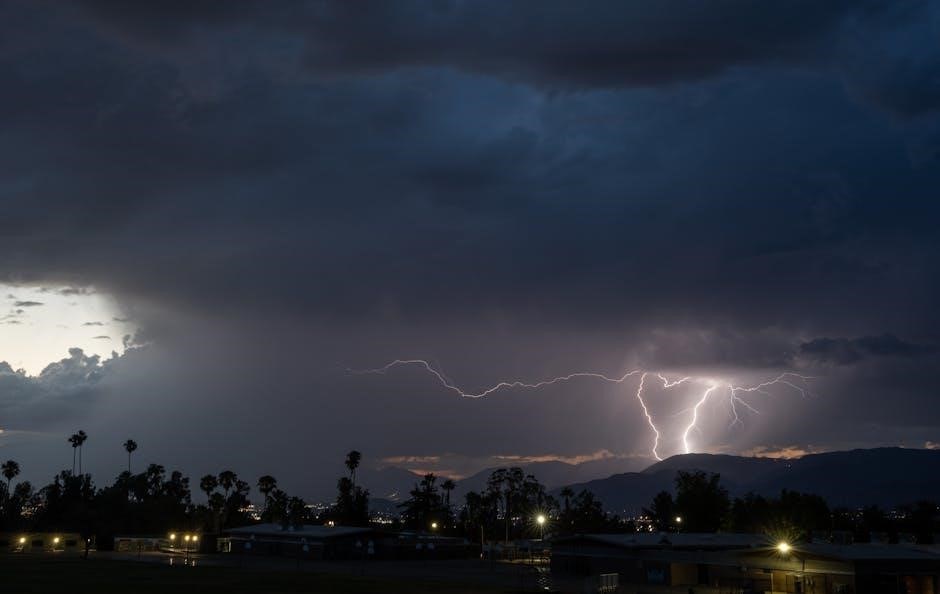The lightning bolt symbol on your Dodge Ram’s dashboard indicates a potential issue with the vehicle’s electronic throttle control system․ Understanding its significance is crucial for safe driving and maintaining your vehicle’s health․
1․1 Overview of the Lightning Bolt Symbol
The lightning bolt symbol, often yellow or orange in color, represents a warning related to your Dodge Ram’s electronic throttle control or related systems․ It may flash or remain steady, indicating varying levels of urgency․ This symbol is part of the vehicle’s dashboard warning system, designed to alert drivers to potential issues that could affect performance or safety․ Understanding its meaning is essential for prompt action and maintaining your vehicle’s optimal condition․ The lightning bolt is a critical visual cue that signals the need to investigate further․
1․2 Importance of Understanding Dashboard Warning Lights
Dashboard warning lights, like the lightning bolt symbol, are vital indicators of your vehicle’s health․ Ignoring them can lead to severe damage or safety risks․ Understanding these lights helps you identify issues early, preventing costly repairs and ensuring your safety on the road․ Familiarity with warning symbols enables you to take appropriate actions, such as reducing speed or seeking professional help․ Staying informed about dashboard alerts is essential for maintaining your vehicle’s performance and longevity, as well as protecting yourself and others while driving․

What is the Lightning Bolt Symbol on a Dodge Ram?
The lightning bolt symbol on a Dodge Ram represents the Electronic Throttle Control (ETC) system․ It illuminates when the system detects a potential issue, signaling drivers to take action․

2․1 Description of the Lightning Bolt Warning Light
The lightning bolt warning light on a Dodge Ram is a yellow icon resembling a lightning bolt․ It is part of the Electronic Throttle Control (ETC) system and illuminates when the system detects a malfunction․ This light indicates potential issues with the throttle or its related components, signaling the driver to take action․ The symbol is distinct and designed to grab attention, ensuring drivers are aware of the problem․ It may appear alongside other dashboard lights, depending on the severity of the issue․
2․2 When and Why Does It Illuminate?
The lightning bolt warning light illuminates when the Dodge Ram’s Electronic Throttle Control (ETC) system detects a malfunction․ This can occur during sudden acceleration, deceleration, or when the system senses irregular throttle responses․ Issues such as faulty sensors, wiring problems, or throttle body malfunctions trigger the light․ It may also appear if the accelerator pedal sensor or throttle position sensor sends incorrect signals․ The light serves as an early warning system, prompting the driver to address potential issues before they escalate, ensuring safer vehicle operation and preventing further damage․

Why Does the Lightning Bolt Light Come On?
The lightning bolt light illuminates due to issues with the Electronic Throttle Control system, such as faulty throttle sensors, wiring problems, or control module malfunctions in your Dodge Ram․

3․1 Faulty Throttle Position Sensor
A faulty throttle position sensor is a common cause of the lightning bolt light․ This sensor monitors the throttle valve’s position and sends signals to the engine control module․ If it fails, the engine may stumble, hesitate, or idle roughly․ Symptoms include erratic acceleration and difficulty maintaining speed․ Dirt, grime, or worn components can cause inaccuracies․ Replacing or cleaning the sensor may resolve the issue․ Ignoring this problem can lead to decreased performance and fuel efficiency, potentially causing more severe damage over time․ Always consult a professional for proper diagnosis and repair․
3․2 Electronic Throttle Control Issues
Electronic throttle control (ETC) issues can trigger the lightning bolt light․ The ETC system regulates throttle valve operation electronically, ensuring precise engine performance․ Faults in sensors, wiring, or the throttle body can disrupt communication between components․ Symptoms include rough idling, hesitation during acceleration, or unexpected throttle responses․ Ignoring these issues can lead to reduced power, poor fuel efficiency, or even engine stalling․ Addressing ETC problems promptly is essential to maintain vehicle performance and safety․ A professional mechanic should diagnose and repair these complex electronic systems to prevent further complications․
3․3 Wiring or Connection Problems
Wiring or connection issues can cause the lightning bolt light to illuminate․ Damaged, corroded, or loose wires in the throttle control system disrupt communication between components․ This can lead to intermittent or erratic throttle responses․ Symptoms may include hesitation, stumbling, or a lack of power when accelerating․ Inspecting the wiring harness and connections is crucial, as exposure to heat, moisture, or physical damage can compromise the system․ Addressing these issues promptly is vital to restore proper electronic throttle control and prevent further complications․ Professional diagnosis is often necessary for accurate repairs․
3․4 Accelerator Pedal Sensor Malfunction
An accelerator pedal sensor malfunction can trigger the lightning bolt light․ This sensor monitors the pedal’s position and sends signals to the engine control module․ If it fails, the system may receive incorrect data, leading to erratic throttle behavior․ Symptoms include inconsistent acceleration, hesitation, or unresponsive pedal input․ Dirt, wear, or electrical issues often cause malfunctions․ Cleaning or replacing the sensor may resolve the problem․ In some cases, recalibration is needed․ If DIY troubleshooting doesn’t work, professional assistance is recommended to ensure proper function and safety․
3․5 Software Glitches in the Engine Control Module
Software glitches in the engine control module (ECM) can cause the lightning bolt light to illuminate․ The ECM manages critical systems, including throttle control․ If its software malfunctions, it may send incorrect signals, disrupting normal operation․ Symptoms include erratic engine behavior, rough idling, or unexpected throttle responses․ Updating or reflashing the ECM software often resolves the issue․ In some cases, a simple restart of the engine can clear temporary glitches․ If problems persist, professional diagnostic tools are necessary to identify and fix the software-related fault․
What to Do When the Lightning Bolt Light Comes On
When the lightning bolt light illuminates, drive safely, check for other warning lights, and reduce speed․ Avoid sudden acceleration and consider consulting a professional if issues persist․
4․1 Check the Dashboard for Additional Warning Lights
When the lightning bolt light appears, inspect the dashboard for other warning lights, such as the check engine or traction control lights․ Multiple lights indicate a more complex issue․ Note the combination of lights and their color (red, yellow, or orange) to assess severity․ This step helps identify if the problem is isolated or part of a larger system failure․ Documenting the pattern of lights can also assist in diagnosing the root cause during repairs․
4․2 Reduce Speed and Avoid Sudden Acceleration
When the lightning bolt light illuminates, reduce your speed immediately to minimize strain on the engine and transmission․ Avoid sudden acceleration, as this could worsen the underlying issue․ Maintain a steady, moderate pace to ensure control of your vehicle․ Sudden movements may exacerbate the problem, potentially leading to further damage or safety risks․ Continue driving cautiously but safely to your destination or a repair shop․ This precaution helps prevent the situation from escalating while you address the issue․
4․3 Use Cruise Control with Caution
If your Dodge Ram is equipped with cruise control, use it cautiously when the lightning bolt light is on․ Engaging cruise control may lead to unpredictable throttle responses, as the system relies on the same electronic components that might be malfunctioning․ If you choose to use it, monitor your speed and be prepared to disengage it immediately if you notice any unusual behavior․ Avoid setting cruise control in heavy traffic or uneven road conditions to maintain better control of your vehicle․

4․4 Perform a Basic Troubleshooting Check
When the lightning bolt light appears, start with a basic troubleshooting check․ Inspect the throttle cable and connections for any signs of damage or looseness․ Ensure the accelerator pedal is functioning properly and free from obstructions․ Check for any error codes using a scan tool, which can provide insights into the specific issue․ Additionally, verify that all electrical connections under the hood and near the throttle are secure․ If you identify a loose connection, tighten it and see if the light resets․ This simple check can often resolve the issue or point you toward the root cause․
4․5 When to Contact a Professional Mechanic
If the lightning bolt light persists after basic troubleshooting, or if you’re unsure about the cause, it’s essential to contact a professional mechanic․ They have the tools and expertise to diagnose complex issues like faulty sensors, wiring problems, or software glitches․ Don’t attempt repairs beyond your knowledge, as this could worsen the problem․ A certified technician can perform a thorough inspection, clear error codes, and recommend necessary repairs to ensure your Dodge Ram operates safely and efficiently․ Prompt action can prevent further damage and costly fixes․

How to Fix the Lightning Bolt Warning Light
To fix the lightning bolt warning light, identify the root cause, such as faulty sensors or wiring issues, and address them promptly․ Consult a professional if complex․
5․1 DIY Repairs and Solutions
DIY repairs for the lightning bolt warning light may include cleaning the throttle body, checking wiring connections, or resetting the system․ Start by inspecting the throttle position sensor and accelerator pedal for dirt or wear․ Use a throttle body cleaner to remove grime, which can disrupt sensor accuracy․ Ensure all electrical connections are secure and free from corrosion․ If issues persist, consider resetting the engine control module using a scan tool or disconnecting the battery temporarily․ Always refer to your owner’s manual for specific guidance․
- Clean the throttle body and sensor․
- Check and secure wiring connections․
- Reset the system using a scan tool or battery disconnect․
5․2 Professional Diagnostic and Repair Options
For persistent issues, consulting a professional mechanic is recommended․ They will use advanced diagnostic tools to identify the root cause, such as faulty sensors or software glitches․ Repairs may involve replacing the throttle position sensor, accelerator pedal, or updating the engine control module’s software․ A professional can also perform a thorough system reset and ensure all components are functioning correctly․ This approach guarantees accurate diagnosis and reliable fixes, preventing further complications and ensuring your Dodge Ram operates safely and efficiently․
- Advanced diagnostic testing with specialized tools․
- Replacement of faulty sensors or components․
- Software updates for the engine control module․
- Comprehensive system reset and inspection․

How to Reset the Lightning Bolt Light
Resetting the lightning bolt light involves addressing the underlying issue and clearing the error codes․ This can be done using a scan tool, manual methods, or professional services․
- Use a code reader to clear error codes․
- Perform a manual reset by disconnecting the battery․
- Consult a professional for complex system resets․
6․1 Manual Reset Methods
To manually reset the lightning bolt light, start by disconnecting the negative battery terminal․ Wait 10-15 minutes to allow the system to reset․ Reconnect the terminal and turn the ignition to the “on” position without starting the engine․ If the light remains off, the reset was successful․ If it reappears, further diagnosis is needed․ This method may not work for all issues, so additional troubleshooting or professional assistance may be required․
- Disconnect the negative battery cable․
- Wait for the system to reset․
- Reconnect and test the system․
6․2 Using a Code Reader or Scan Tool
Using a code reader or scan tool is an effective way to reset the lightning bolt light․ Connect the tool to the vehicle’s OBD-II port, located under the dashboard․ Follow the device’s instructions to read and clear the trouble codes․ Once cleared, turn the ignition on and off to reset the system․ If the light remains off, the issue has been resolved․ This method is more reliable than manual resets and provides detailed diagnostic information․
- Connect the scan tool to the OBD-II port․
- Read and clear the stored trouble codes․
- Turn the ignition on/off to reset the system․
6․3 Professional Reset Services
Professional reset services are recommended for accurate and reliable results․ A certified mechanic will use advanced diagnostic tools to identify and clear the codes, ensuring the system is reset properly․ This service is especially useful if the issue persists after manual or scan tool attempts․
- A certified mechanic uses advanced tools for precise code clearance․
- Professional services ensure the system is fully reset and functioning correctly․
- Recommended if the light persists after DIY methods․
Preventive Maintenance Tips
Regular inspections and proper sensor maintenance can prevent the lightning bolt light from appearing․ Ensure all components are functioning correctly to avoid unexpected issues․
- Check throttle and sensor connections regularly․
- Update software and firmware as recommended․
- Avoid sudden acceleration to reduce system stress․
7․1 Regular Vehicle Inspections
Regular inspections are essential to identify potential issues before they escalate․ Check the throttle system, sensors, and wiring for damage or corrosion․ Ensure all connections are secure and clean․ Inspect the accelerator pedal and throttle position sensor for proper alignment and function․ Perform these checks monthly or before long trips to maintain optimal performance․ Addressing minor issues early can prevent the lightning bolt light from illuminating and ensure your Dodge Ram runs smoothly․
- Inspect throttle and sensor connections for damage․
- Check for software updates to maintain system functionality․
- Ensure proper alignment of the accelerator pedal․
7․2 Maintaining Proper Throttle and Sensor Function
Maintaining your Dodge Ram’s throttle and sensor function is vital to prevent the lightning bolt light from appearing․ Regularly clean the throttle body to remove dirt and debris that can disrupt airflow․ Inspect sensors for damage or corrosion and ensure all electrical connections are secure․ Use a scan tool to monitor sensor performance and address any codes promptly․ Avoid using harsh chemicals that could damage components․ Proper maintenance ensures smooth acceleration and prevents system malfunctions․
- Clean the throttle body periodically․
- Check sensors for damage or corrosion․
- Use a scan tool to monitor sensor performance․
7․3 Updating Software and Firmware
Regularly updating your Dodge Ram’s software and firmware is essential for optimal performance and to prevent issues that could trigger the lightning bolt warning light․ Manufacturers release updates to fix bugs, improve functionality, and enhance compatibility․ Check for updates through the dealership or official manufacturer portals․ Use approved tools to avoid damaging the system․ Keeping your vehicle’s technology up-to-date ensures smooth operation and reduces the risk of electronic throttle control-related problems․
- Check for software updates regularly․
- Use manufacturer-approved tools for updates․
- Ensure updates are installed by professionals if unsure․

Common Mistakes to Avoid
Avoid ignoring the warning light, attempting repairs without proper knowledge, and neglecting routine maintenance, as these can worsen issues or lead to safety risks․
- Never ignore the lightning bolt warning light․
- Do not attempt repairs without proper understanding․
- Regular maintenance is crucial to prevent issues․
8․1 Ignoring the Warning Light
Ignoring the lightning bolt warning light can lead to more severe issues, such as engine damage or loss of control․ It may result in costly repairs and safety risks․ Failing to address the problem promptly can cause the vehicle to malfunction unexpectedly, leaving you stranded․ Always investigate the cause of the warning light to ensure your safety and maintain your vehicle’s performance․ Delaying action can exacerbate underlying problems, leading to more complex and expensive solutions down the road․
8․2 Attempting Repairs Without Proper Knowledge
Attempting repairs without proper knowledge can worsen the issue and damage your vehicle further․ Modern vehicles, like the Dodge Ram, rely on complex electronic systems that require specialized tools and expertise․ DIY fixes without understanding the root cause can lead to costly mistakes, such as damaging sensors or the throttle system․ This can result in more severe problems, including engine failure or unsafe driving conditions․ Always consult a professional mechanic to ensure repairs are done correctly and safely, avoiding unnecessary risks and expenses․
8․3 Overlooking Routine Maintenance
Overlooking routine maintenance can lead to underlying issues that trigger the lightning bolt warning light․ Regular checks, such as cleaning sensors, inspecting wiring, and updating software, are essential for preventing system malfunctions․ Neglecting these tasks can result in more severe and costly repairs down the line․ Consistent maintenance ensures optimal performance and helps identify potential problems early, reducing the risk of unexpected issues while driving․ Always prioritize scheduled maintenance to keep your Dodge Ram running smoothly and avoid unnecessary complications with the electronic throttle control system․

The lightning bolt symbol serves as a critical alert for Dodge Ram drivers, emphasizing the need for prompt attention to maintain vehicle performance and safety on the road․
9․1 Summary of Key Points
The lightning bolt symbol on a Dodge Ram indicates issues with the electronic throttle control system․ It can illuminate due to faulty sensors, wiring problems, or software glitches․ Drivers should check for additional warning lights, reduce speed, and avoid sudden acceleration․ Basic troubleshooting, such as inspecting connections, may resolve the issue․ However, professional diagnostic tools are often necessary for accurate repairs․ Regular maintenance, including sensor inspections and software updates, can prevent future occurrences․ Addressing the issue promptly ensures vehicle safety and optimal performance․
9․2 Final Thoughts on Dashboard Warning Lights
Dashboard warning lights, like the lightning bolt symbol, are essential for driver awareness and vehicle maintenance․ Ignoring them can lead to severe consequences, including engine damage or safety risks․ Understanding each symbol and its implications empowers drivers to take timely action․ Regular inspections, proper repairs, and staying informed are key to maintaining your vehicle’s health․ Remember, dashboard lights are not just alerts—they are vital tools for ensuring your safety and the longevity of your Dodge Ram․
